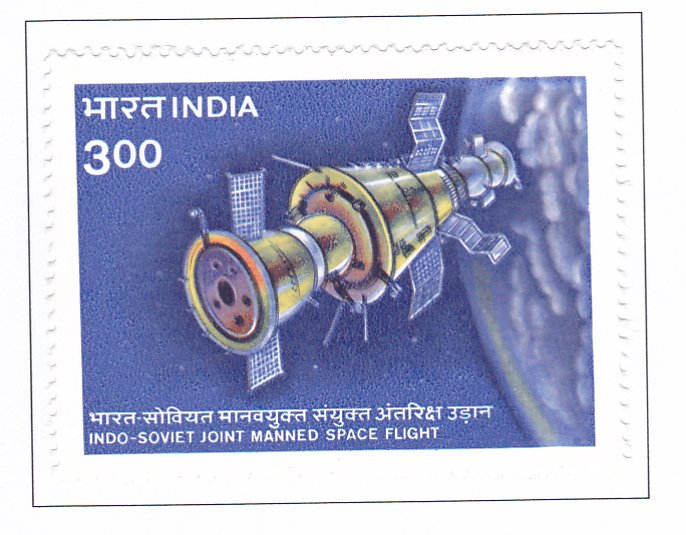Indo-Soviet Joint Manned Space Flight

Technical Data
| Date of Issue | April 3, 1984 |
|---|---|
| Denomination | Rs. 3 |
| Quantity | 1,500,000 |
| Perforation | comb 14 |
| Printer | Security Printing Press, Nashik |
| Watermark | No Watermark |
| Colors | Multicolor |
| Catalog Codes |
Michel IN 987 Stamp Number IN 1058 Yvert et Tellier IN 802 Stanley Gibbons IN 1125 |
| Themes | Space Traveling | Spacecraft |
The Indo-Soviet Joint Manned Space Flight, marking a significant milestone in space exploration, launched the first Indian into space from April 3, 1984, to April 11, 1984. This historic mission resulted from an agreement between the governments of India and the USSR, facilitating the participation of an Indian cosmonaut in a Soviet space flight.
Selection and Training
Two distinguished Indian Air Force officers, Squadron Leader Rakesh Sharma and Wing Commander Ravish Malhotra, were selected through a rigorous process for training at the Yuri Gagarin Cosmonaut Training Center in Star City, Russia. Both officers qualified for the space mission, with one forming the main crew and the other as part of the standby crew.
Main and Standby Crews
The main crew for this mission consisted of:
- Col. Yuri Malyshev: Pilot Cosmonaut and Commander
- Sqn. Ldr. Rakesh Sharma: Researcher Cosmonaut
- Mr. Gennady Strekalov: Engineer Cosmonaut
The standby crew included:
- Col. Anatoly Berezovoi: Pilot Cosmonaut
- Wg. Cdr. Ravish Malhotra: Researcher Cosmonaut
- Mr. Georgi Grechko: Engineer Cosmonaut
Scientific Experiments
The mission involved advanced experiments in various fields:
- Bio-medicine: Sponsored by the Institute of Aviation Medicine of the Air Force.
- Material Science: Sponsored by the Defence Metallurgical Research Laboratory of the Defence Research and Development Organisation.
- Remote Sensing: Sponsored by the Indian Space Research Organisation (ISRO).
These experiments were conducted in collaboration with Soviet research institutions, some for the first time, promising intriguing results.
Spacecraft and Launch
The crew was launched aboard the Soyuz T-11 transporter spacecraft with the help of the Soyuz rocket from Baikonur Cosmodrome on April 3, 1984. Soyuz T-11 docked with the Salyut-7 space station, which had been in orbit since April 19, 1982, at an altitude of 360 kilometers. The Salyut-7 station was already inhabited by a three-member Soviet crew comprising Commander Col. Leonid Kizim, Flight Engineer Vladimir Solovyov, and Cardiologist Dr. Oleg Atkov, who received the joint Indo-Soviet crew upon their arrival.
Mission Completion and Return
The joint crew conducted various experiments during their eight-day mission. They were expected to return to Earth on April 11, 1984, bringing back logs of their activities, symbolic items taken to space, and scientific data from their experiments.
Commemoration
The Indian Posts & Telegraphs Department commemorated this historic event by issuing a special stamp, celebrating the collaboration and achievements of the Indo-Soviet space mission.
Acknowledgments
(Text courtesy: Air Headquarters).
